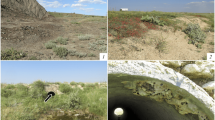Summary
The structure and populations of seven nests ofHalictus scabiosæ were studied in Geneva during July and August, 1964. Cells, containing brood of various ages, were radially arranged along the branching burrows. The one to six females in each nest did not belong to distinct worker and queen castes. This is in contrast to reports of distinct castes in what appears to be the same species from France. Most pollen collectors in the Geneva population were inseminated and some probably laid eggs.
Zusammenfassung
Die Struktur und die Bewohner von sieben Nestern vonHalictus scabiosæ, die im Juli und August 1964 in der Gegend um Genf gesammelt wurden, werden beschrieben. Zellen mit Brut verschiedenen Alters sind entlang verzweigter Gänge radiär angeordnet. Bis zu sechs Weibchen befanden sich in einem einzelnen Nest. Sie waren nicht in Königinnen und Arbeiterinnen differenziert, wie dies von Bienen aus Frankreich berichtet ist, die wahrscheinlich zur selben Art gehören. Die meisten Pollen-Sammlerinnen der Genfer Population waren befruchtet und einige von ihnen legten auch wahrscheinlich Eier.
Résumé
La structure et la population de sept nids deHalictus scabiosæ ont été étudiées à Genève durant les mois de juillet et d'août 1964. Des cellules contenant du couvain d'âge différent sont disposées en rayons le long de terriers qui se ramifient. Chaque nid était occupé par une à six femelles qui n'appartenaient pas à une caste distincte d'ouvrières ou de reine. La plupart des abeilles qui collectent le pollen furent inséminées et quelques-unes probablement pondèrent des œufs.
Similar content being viewed by others
Literature Cited
Batra (S. W. T.), 1965. — The life cycle and behavior of the primitively social bee,Lasioglossum zephyrum (Halictidæ).Univ. Kansas Sci. Bull.,46, p. 359–422.
Fabre (J. H.), 1915. —Bramble-bees and others. Dodd, Mead, Co., N. Y., 450 p. (Transl. de Mattos).
Fahringer (J.), 1914. — Ueber den Nestbau zweier Bienen.Zeitschr. wiss. Insektenbiol.,10, p. 16–20.
Grandi (G.), 1954. — Contributi allo conoscenza degli imenotteri aculeati. XXVI.Boll. Istituto Entom. Univ. Bologna,20, p. 81–255.
Michener (C. D.) andWille (A.), 1961. — The bionomics of a primitively social bee,Lasioglossum inconspicuum.Univ. Kansas Sci. Bull.,42, p. 1123–1202.
Quénu (Cécile), 1954. — Etude systématique des apides du Périgord noir. Le genreHalictus (Printemps-été 1953).Ann Soc. Ent. France,123, p. 157–163.—Quénu (Cécile), 1957. Sur les femelles d'été deHalictus scabiosæ (Rossi).C. R. Acad. Sci. Paris,244, p. 1073–1076.
Sakagami (S. F.) andMichener (C. D.), 1962. —The nest architecture of the sweat bees. Univ. Kansas Press, Lawrence, 135 p.
Author information
Authors and Affiliations
Additional information
Contribution No. 1303 from the Department of Entomology, The University of Kansas, Lawrence.
Rights and permissions
About this article
Cite this article
Batra, S.W.T. Nesting behavior ofHalictus scabiosæ in Switzerland (Hymenoptera, Halictidæ). Ins. Soc 13, 87–92 (1966). https://doi.org/10.1007/BF02223564
Issue Date:
DOI: https://doi.org/10.1007/BF02223564



